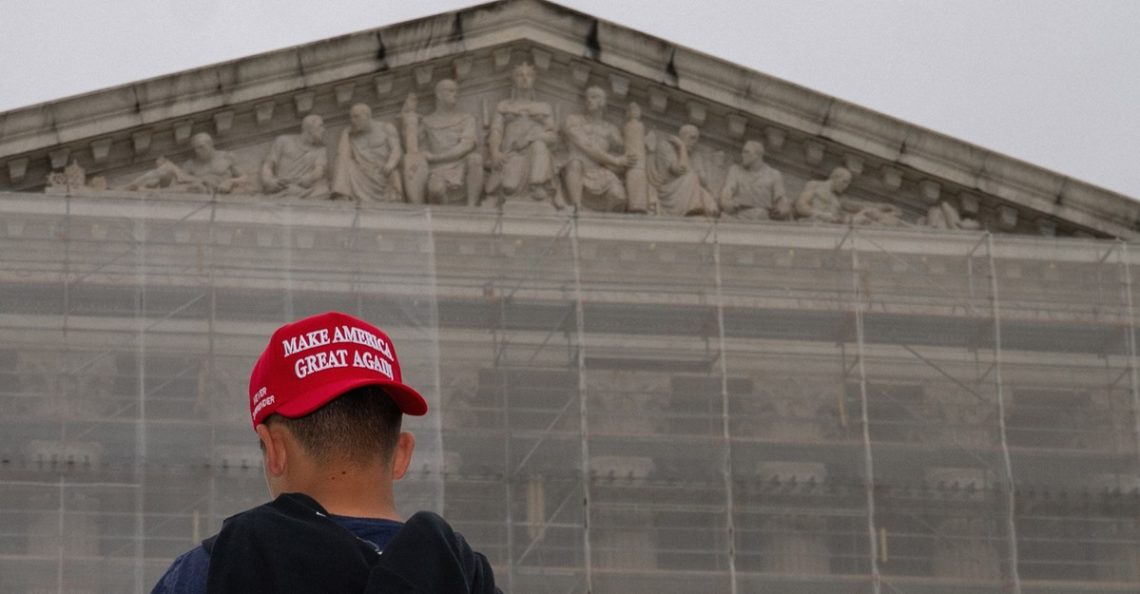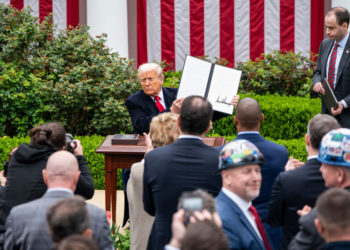Today, the Supreme Court is hearing oral arguments in one of those rare cases that could reshape all three branches of government. The justices deciding Learning Resources, Inc. v. Trump, a challenge to the current tariff regime, could determine whether the imperial presidency is entrenched or arrested. They could either cajole Congress out of its dormancy or render it even more inert. And they could buttress the legitimacy of the Court’s conservative majority—which in the past decade has aggressively intervened to limit the administrative state’s domestic operations—or undermine it by applying different standards to presidents of different parties.
The Court will consider whether Donald Trump’s tariffs, which have roiled global markets and rankled America’s allies, are unconstitutional because the president imposed them unilaterally. After decades of near-zero duties, America now has an overall tariff rate of about 17 percent—the highest since 1935. This has come about through presidential decree alone, with no congressional input whatsoever. Under Chief Justice John Roberts, the Court has become more indulgent toward the president’s power over foreign affairs and within the executive branch itself (in keeping with the so-called unitary-executive theory). But taxation and the imposition of tariffs are core powers of Congress, explicitly assigned to it by the Constitution. Crediting the president’s powers here would be an aberration from the Court’s own recent precedents.
The Trump administration argues that it can set tariffs however it likes by relying on a maximalist reading of the International Emergency Economic Powers Act, or IEEPA. That 1977 law, allowing the president to regulate international commerce after declaring a national emergency, has been the underlying justification for many American sanctions—including those Ronald Reagan imposed on apartheid South Africa in 1985 and those Joe Biden placed on Russia after it invaded Ukraine in 2022. Although the law is supposed to be invoked only in cases of “unusual and extraordinary” threats, presidents have regularly relied on IEEPA for extended durations because of the broad authorities that it grants them. The state of emergency originally declared by Jimmy Carter during the Iran hostage crisis of 1979 has been annually renewed up to the present day.
But no president had ever used IEEPA to impose tariffs before. The only precedent is Richard Nixon’s imposition of a 10 percent “import surcharge” for less than five months after America went off the gold standard and the first Bretton Woods exchange-rate system collapsed. Trump imposed his tariffs by simply declaring America’s trade deficit to be a national emergency. In any plain sense of the word emergency, the trade deficit is not one—it is neither an existential risk to the country nor new, having existed for 50 years. Under Trump’s logic, a future Democratic president could easily declare climate change a national emergency, ban the export of American petroleum, place punitive tariffs on petrostates, and implement a carbon tax on all imports. For the current Court to countenance such a unilateral assertion of presidential power would be almost unimaginable.
The same reasoning ought to apply to a Republican administration too. The conservative supermajority on the Court has advanced at least four doctrines that, if applied evenhandedly, should lead to the checking of Trump’s tariff rampage. The first is “plain textualism”—the idea, championed by Neil Gorsuch, among others, that laws should be interpreted by the plain meaning of their words. The words tariff and duty do not appear anywhere in IEEPA’s description of the president’s emergency powers. Instead, the administration argues that the authority delegated to the president to “regulate … importation and exportation” must implicitly include tariffs.
To deal with such canny innovations, the Roberts Court has methodically built up a second doctrine: “major questions,” which demands “clear authorization” from Congress when, on matters of great economic or political significance, the executive branch claims far-reaching powers from “vague statutory grants” never interpreted in such a way before. The Court has forcefully applied that doctrine even in presidentially declared emergencies that are genuine crises. The justices struck down a Biden-administration effort during the coronavirus pandemic to implement a massive policy of student-loan forgiveness by citing the education secretary’s emergency-waiver authority. In 2021, the Court also struck down an attempt by the Biden administration to impose a nationwide eviction moratorium, because this “would give the CDC a breathtaking amount of authority.” If the major-questions doctrine does not apply to Trump’s application of tariffs—a never-before-used, sweeping declaration of authority over the multitrillion-dollar flow of goods—then it would be left incoherent.
The third relevant line of reasoning, an intellectual predecessor to the major-questions doctrine, is known as “nondelegation”—the idea that no branch of government can give away its constitutionally assigned powers to another. Article I of the Constitution explicitly reserves to Congress the “power to lay and collect taxes, duties, imposts and excises” and “to regulate commerce with foreign nations.” Yet, at present, the president is deciding what rates are charged.
The fourth doctrine is the special variation on originalism called “history and tradition,” developed by the Roberts Court, most notably to overturn Roe v. Wade and expand the right to bear arms. Throughout American history, starting with the Tariff Act of 1789, Congress has taken charge of setting the tax rate charged on imported goods. Debates over tariffs have been heated: The Tariff of Abominations in 1828 led to a nullification crisis in the South; the Smoot-Hawley Tariff Act in 1930 deepened the incipient Great Depression. But the decisions to enact these measures happened within the halls of Congress.
When elaborating on the necessity of the separation of powers in The Federalist Papers, James Madison argued, quoting Montesquieu, that “there can be no liberty where the legislative and executive powers are united in the same person.” Thomas Jefferson warned in his “Notes on the State of Virginia” that the concentration of these separate powers “is precisely the definition of despotic government.”
Over the past year, American tariffs have smacked of exactly the monarchical arbitrariness that prompted the Founding Fathers to rebel. The scale of Trump’s declared economic emergencies varies closely with the president’s moods. In April, using the trade deficit as pretext, the president imposed tariffs on the rest of the world. The individual rate that a country is charged goes down if its leaders commit to docile dealmaking; it goes up if they are defiant. Thus, tariffs on Chinese goods have gyrated wildly, from nearly 150 percent at the height of the president’s anger to something near 50 percent today, after the latest mollification. (Never mind that America’s trade deficit has actually increased over this period.)
China is America’s preeminent geopolitical rival, a fact that gives Trump’s tariffs at least a superficial logic. When targeting friendlier governments, the president’s emergency declarations are strained beyond credulity. Because Brazil put Jair Bolsonaro on trial over his role in an attempted coup, Trump—who likes his former Brazilian counterpart—announced a 40 percent tariff surcharge (on the ostensible grounds that the “breakdown in the rule of law” in Brazil constituted an emergency in America). After Ontario sponsored an advertisement that quoted Ronald Reagan denouncing tariffs, Trump announced that Canada’s tariffs would go up by 10 percent. The executive order promulgating this has not been released yet, but it will probably rely on adjusting the emergency tariffs already imposed on Canada because of the flow of illegal immigrants and fentanyl into the United States. In reality, both are minimal.
On its way to the Supreme Court, the administration made arguments in three lower courts—a district court, an appeals court, and the Court of International Trade—and lost them all. If the Court were to affirm these rulings and sharply curb Trump’s powers under IEEPA, this would be a serious embarrassment to the administration. Of the many cudgels enjoyed by the president, the ability to impose tariffs by fiat may be his favorite. The Treasury Department may be ordered to issue refunds for $90 billion already collected.
Still, the global trading system would not revert to the pre-Trump, free-trade era centered on the World Trade Organization. The WTO has three main functions: to liberalize trade, monitor countries, and settle disputes. “None of those had been operating well for some time,” Michael Froman, the president of the Council on Foreign Relations and the former top American trade negotiator under Barack Obama, told me. “Trump might have put the final nail in the coffin.”
Many other laws explicitly authorize the president to impose tariffs based on national-security concerns, generally after the fuss of a formal investigation. Trump made expansive use of the provisions in his first term, and Biden continued to use these and added his own tariffs. And other untapped relics are still on the statute books. One of them, Section 338 of the Smoot-Hawley Tariff Act, would allow Trump to slap retaliatory tariffs of 50 percent against countries with unfair trade practices. “It’s pretty clear they’ve been teeing up 338 as a contingency plan,” Kathleen Claussen, a law professor at Georgetown University, told me, adding, “I think they could reconstruct exactly what they have right now.”
Even so, it matters that the president pursues his agenda through legal and constitutional means. Roberts is a conservative jurist, yes, but he is also an institutionalist who wants to preserve the Court’s independence and legitimacy. He must also contend with a president who has walked up to the line of defying Court orders and who is aggressively jawboning the Court about the tariff decision, which Trump says will be the Court’s “most important” ever. “If they took away tariffs, then they’ve taken away our national security,” he recently told Fox News. He even half-proposed and half-threatened to attend the oral arguments in person, which likely would be a presidential first.
Giving Trump free license to continue setting tariffs under IEEPA would avoid a nasty confrontation. But such a decision would be harmful to all three branches: The doctrines that conservative jurists have painstakingly advanced would be intellectually diminished, Congress would be rendered even more of a rump, and the imperium of the presidency would be permanently expanded. Future presidents would not abstain from accruing awesome economic powers with a simple emergency declaration. They could subsidize certain industries, tax or ban disfavored products, and order financial institutions to enforce compliance. If that sounds like the executive branch legislating, that is exactly right. But that is also what is happening today.
The post Will the Supreme Court Side With Trump—Or Itself? appeared first on The Atlantic.




